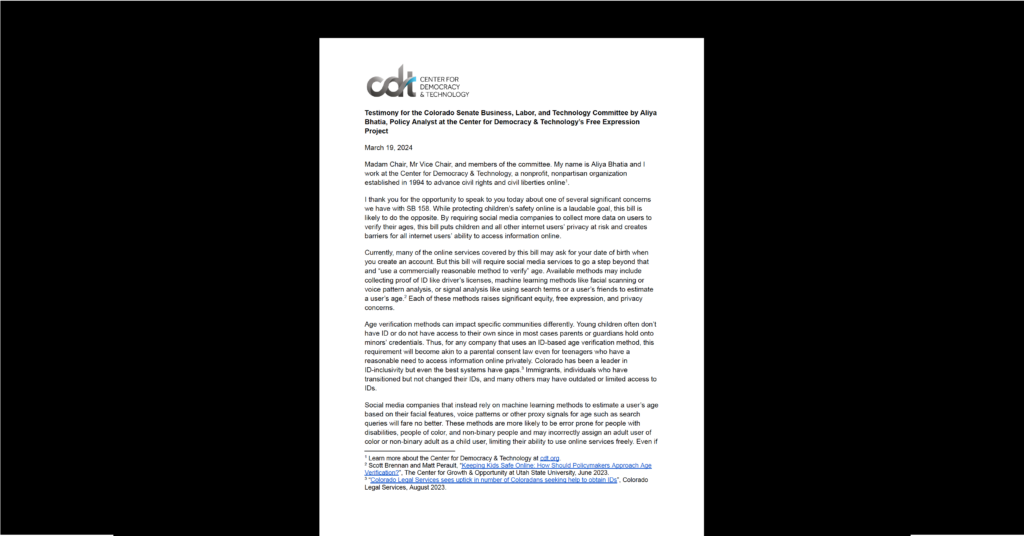Beyond the Bailout: Congress Passes a Flurry of ‘Child Safety’ Bills
While the public’s attention was focused on the drama unfolding around the economic bailout, it was actually a busy time for other bills to get pushed – sometimes under the cover of the bailout darkness. Just before recess, Congress considered parts of four “child safety” bills, acted on three, and sent two to the White House. While not all the provisions in these bills raise red flags, some language gives free expression advocates plenty to worry about. One bill that is awaiting a Presidential signature confronts child pornography head on in a constructive way is S. 1738, the “PROTECT Our Children Act of 2008. Among the important and positive steps taken in this new law are (a) a dramatic increase in funding for fighting child pornography, (b) a mandate to the Department of Justice that it develop a real strategy to fight such material, and (c) the provision of new forensic and other resources to help state law enforcement protect kids. These provisions should – if the bailout leaves any money to actually spend on law enforcement – really help in the fight against child pornography.
Congress should have stopped there; it didn’t. Some in Congress insisted that the core parts of S. 519 – the “SAFE Act” – be added to S. 1738 before passage. Among the most problematic provisions in S.519 – which was never publicly debated by any committee–is the outsourcing of significant law enforcement investigative functions to the National Center for Missing & Exploited Children (NCMEC), which as a non-governmental entity operates outside of the core constitutional and legal protections that govern (or should govern) our criminal justice system (such as the 4th Amendment, the Privacy Act, the Freedom of Information Act, etc.). Although NCMEC makes valuable contributions in the child safety arena, the growing trend in Congress to outsource law enforcement functions to a nominally private group—without any serious oversight or procedural protections— takes us down a dangerous path.
Another part of the SAFE Act that was crammed into S. 1738 federalizes a “blacklist” program that NCMEC had been running with ISPs to alert the service providers to child pornography. Although the program might have been desirable (and probably avoided constitutional concerns because NCMEC is private), now that Congress has authorized the program it runs smack into the clear constitutional prohibition against a governmental blacklist of content under a long line of “prior restraint” cases. Congress did make clear that NCMEC’s blacklist could only be used for a very narrow category of child pornography, but this narrowing of the program does not avoid its clear unconstitutionality. This Congressional scrum surrounding S. 1738 and S. 519 included a healthy dose of election year politics; to see what I mean go online and check out the sponsors of these two bills.
The other bill Congress passed and that is now on the President’s desk is S. 431, the “Keeping the Internet Devoid of Sexual Predators Act of 2008.” This bill creates a national registry of sex offenders’ e-mail addresses; it also allows social networking services to use the list to screen out sex offenders. While this superficially might seem to be a good idea, the bill (even with some good amendments from its original language) has problems and is unlikely to be effective. Among the problems in the bill is that the definition of “social network” sweeps very broadly, reaching a great many of the blogs on the Internet. Although this bill tries to avoid imposing obligations on blogs, there is a risk that the bill will burden blogs, and that the broad definition of “social network” will get used in other attempts to impose regulation on such sites. Moreover, the bill is unlikely to be effective because sex offenders who want to break their terms of release by contacting minors can easily do so by creating new e-mail addresses.
A far more effective approach that Congress could have taken is found in H.R. 719, the House version of the KIDS Act. H.R. 719 would have allowed probation officers of those sex offenders who pose risks for children online to directly limit the ability of those offenders to access social networks. But, instead of enacting this focused and likely effective bill, Congress opted for a broader bill (S. 431) that is unlikely to thwart determined offenders or protect children. The implementation of this law will bear closer scrutiny. Finally, this past Friday the House passed an amended version of S. 602, the “Child Safe Viewing Act of 2007.” This bill – which because of the amendment must now go back to the Senate in a “lame duck” session of Congress after the election – would direct the Federal Communications Commission (FCC) to undertake a formal study of blocking and filtering technology that could be used to control content on the Internet. This bill raises a host of concerns, first and foremost being that it would be the first time that Congress has ever suggested that the FCC should stick its nose into Internet content (which has flourished because it is unregulated).
If this study were limited to assessing “user empowerment” software for parents – technology that CDT strongly supports – it might not be a risky endeavor, but the language of S. 602 appears to encourage the FCC to consider a possible “V-chip” for the Internet and other invasive technology mandates. The bill – thankfully – was amended to only permit a study of these issues, but even an FCC study can be a camel’s nose under the very risky tent of government censorship. We are hopeful that in a “lame duck” session the Senate will have better things to do than to invite the FCC to ponder ways it might censor the Internet.


